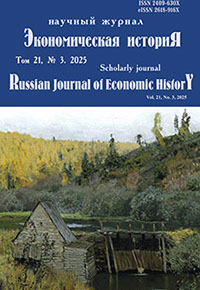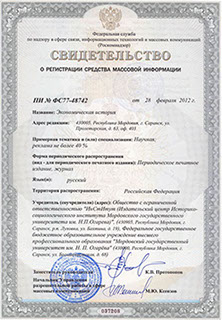Экономическая историЯ
Russian Journal of Economic History
ISSN 2409-630X (Print)
ISSN 2618-916X (Online)
Expert board:
- Scientific Council of RAS on economic history;
- Research and Educational Center «The economic history of Central Russia and the Middle Volga region» of Ogarev Mordovia State University;
- Center of Economic History of Lomonosov Moscow State University
Navigation
ISSN 2409-630X (Print), ISSN 2618-916X (Online)
DOI: 10.24412/2409-630X.070.021.202503.291-301
Olga V. Koshina1, Larisa G. Skvorcova2
1, 2 National Research Ogarev Mordovia State University (Saransk, Russia),,
1 e-mail: koshinaolga@rambler.ru
2 e-mail: skvorcovalg@inbox.ru
Development of Hemp factories in the Territory of Mordovia in the 1930s – 1960s
Abstract
Introduction. The development of hemp factories in Mordovia in the 1930s – 1960s attracts the attention of researchers in the context of the revival of interest in hemp cultivation and production of hemp products in Russia and the world in recent decades. The decline in hemp production in our country in the second half of the 1980s – 1990s has now been replaced by an increase in production and processing, an expansion of the range of hemp products in the Republic of Mordovia and in Russia as a whole.
Materials and Methods. The study was based on an integrated approach, analyzing microeconomic processes at the level of the history of regional enterprises against the background of macroeconomic phenomena in the hemp growing industry of the republic and the country. The historical and genetic perspective of the study involved an analysis of the mutual influence of hemp cultivation volumes and the level of development of raw material processing technologies and the production of finished products from this industrial crop.
Results. In the late 1920s – early 1930s, the USSR became one of the world leaders in the hemp growing industry, and Mordovia became one of the regions for the production and primary processing of hemp. In the 1930s, 9 hemp factories were built in the republic. In the early 1960s, the Temnikovsky and Torbeevsky hemp factories were commissioned. In the early 1950s, the production of primary hemp processing occupied one of the leading places in the processing industry of Mordovia. The raw material zone of the industry for the primary processing of hemp included 29 out of 32 districts of the MASSR. The industry received state support: collective farms received additional payment for the delivery of hemp, hemp growers were entitled to increased payment for workdays and advance payments for workdays. High yields of a profitable industrial crop led to the fact that hemp factories could not cope with the processing of the supplied raw materials.
Discussion and Conclusion. Among the problems of hemp plant development, experts note: uneven distribution of plants and hemp fields in the areas where the enterprises are located; insufficient quantity and quality of raw materials due to problems with infrastructure and logistics; insufficiently high level of use of technological equipment and mechanization of auxiliary work; incomplete provision of enterprises with qualified labor.
Keywords: hemp plant, hemp, trusts, fiber, seeds, production, technology.
For citation: Koshina O. V. Skvorcova L. G. Development of Hemp factories in the Territory of Mordovia in the 1930s – 1960s. Ekonomicheskaya istoriya = Russian Journal of Economic History. 2025; 21(3): 291–301. (In Russ.). DOI: 10.24412/2409-630X.070.021.202503.291-301.
© Ogarev Mordovia State University. History and Sociology Institute, 2017
68, Of. 411, Bolshevistskaya St., 430005, The editorial office of the scholarly journal «Russian Journal of Economic History»
Tel.: (8342) 24-25-90; 27-07-11, Fax: (8342) 24-25-90, E-mail: jurnal-econom-hist@isi.mrsu.ru
Designed by A. Napalkov, Email: napalkov@isi.mrsu.ru


